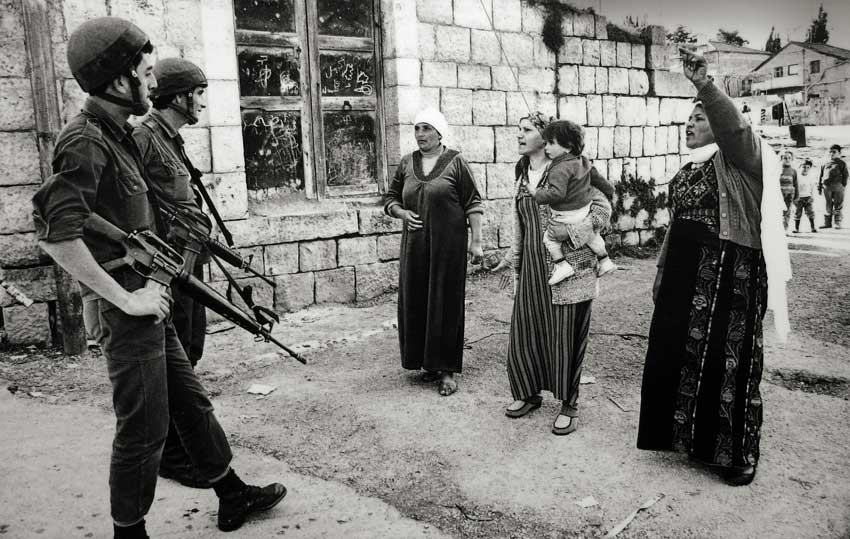
A joint project of the UCLA Burkle Center for International Relations and Zócalo Public Square
Borderlines and Borderlands: Political Oddities at the Edge of the Nation-State
by Alexander C. Diener and Joshua Hagen
When the only thing demarcating the end of one tract of land and the start of another is a highway sign, it is easy to regard such a “border” as arbitrary. Diener and Hagen argue that even the most iconic international borders – from the Strait of Gibraltar to the “Green Line” separating the West Bank and Israel – are no less artificial. The authors point to examples of politically charged borders across the globe to illustrate that once political boundaries become “naturalized” by both sides, they take on new and symbolic meaning. Their argument about the influence of borders on geopolitical identity stretches to a region that lacks borders entirely: the Kurd-inhabited territories of Iraq, Iran, Syria, and Turkey. The authors cite the lack of an identifiable and demarcated Kurdistan as a source of divisiveness within the Kurdish population. Kurdistan is only one among ten cases of oddly-shaped borders, each with a history as peculiar as its appearance. Examples – from Russia’s Kaliningrad Exclave to Argentina’s Misiones Province – demonstrate that these “arbitrary pen lines of men gathered around maps” can have far-reaching and long-lasting implications for the populations they bisect.
– Lina Kaisey
Buy the book: Skylight Books, Powell’s, Amazon
Outsourcing War & Peace: Preserving Public Values in a World of Privatized Foreign Affairs
by Laura A. Dickinson
The gradual shift from “the large bureaucratized military and foreign policy apparatus” of the 20th century to an increasingly privatized foreign security service has major ramifications for the United States, according to Outsourcing War & Peace. Dickinson argues that we need not discuss whether the U.S should outsource security – private contractors have become a staple of American involvement in foreign countries, and their role is unlikely to diminish – but how the government should address the threats to human rights, security and transparency that results. For example, when the contractors involved in the scandal at Abu Ghraib were identified, how should they have been held accountable for their “gross abuses” of power and violations of key democratic principles? Dickinson’s solution for protecting “core public values” and eliminating accountability loopholes boils down to four logical steps: reconciling international and domestic law, reforming contracts and enforcement, creating public participation, and changing the organizational structure of contracting firms. Her portrayal of this newly privatized military world benefits from the added context of examples from the Vietnam War up to current conflicts in the Middle East.
– Trisha Parikh
Buy the book: Skylight Books, Powell’s, Amazon
How Insurgencies End
by Ben Connable and Martin C. Libicki
Connable and Libicki, analysts for The RAND Corporation, argue insurgencies end not with a bang, but a tipping point. Analyzing 89 insurgencies across the globe from 1934 to the present, the authors identify several factors that contribute to their demise. For example, a decrease in the flow of intelligence from local civilians to insurgents belies a potentially fatal decrease in civilian loyalty. And, unsurprisingly, the nation’s system of government plays a role: an “anocracy,” or democracy in name only, is particularly weak against insurgency because it cannot employ the effective repressive tactics of an autocracy, yet enjoys none of the benefits of a truly reformed government. Connable and Libicki are clear that there is no reliable shortcut to end any particular insurgency; even the tipping point can tip back and forth between insurgents and the government. In particularly messy cases, there is no tipping point at all; both sides end up feeling like they lost.
– LK
Buy the book: Powell’s, Amazon
The End of Arrogance: America in the Global Competition of Ideas
by Steven Weber & Bruce W. Jentleson
In Weber and Jentleson’s latest work, they explore the increasingly apparent fact that the United States is no longer at the center of the world. Although U.S. influence remains strong, new countries have entered the “international game” as competitive players. The authors argue that the changing power structure in international relations has eliminated hegemony, and the U.S. must “face the facts, as they say, with both eyes open,” by adapting to the new global system in order to remain competitive and not fall behind. Furthermore, they write, conceptions of justice, war, capitalism, and democracy must change to meet the demands of a rapidly growing globalized society. Unlike during most of the 20th century, power cannot be the main U.S. objective; rather, leaders must focus on the growth and acceptance of new ideas. Thus, the competition among nations is not a race to establish power and become a hegemon, but an ideological battle to resolve the problems arising from globalization.
– TP
Buy the book: Skylight Books, Powell’s, Amazon
Dangerous But Not Omnipotent: Exploring the Reach and Limitations of Iranian Power in the Middle East
by Frederic Wehrey et al.
Iran is sandwiched between Iraq and Afghanistan in more ways than the obvious geographic one. For American foreign policy experts, Iran has always been considered as much of a threat as its neighbors. But according to this RAND analysis, Iran is being too closely compared to a nation that once topped the list of hostile countries: the Soviet Union. The authors characterize the United States’ current policy towards Iran as unnecessarily reliant upon a good-versus-evil paradigm similar to that during the Cold War. The authors list several examples – from Iran’s overlapping and factionalized power structure to its lack of conventional military capabilities – to draw a contrast between the two. Iran views itself as a status quo power, less interested in inciting widespread Islamic revolution than finding a prominent place for itself within the current system. As a result, they argue, the United States’ Cold War tactics don’t address the threats Iran really poses, so the U.S. must a less confrontational stance toward Iran. Their plan for U.S. policy is characterized by direct cooperation on common issues (for example, local narcotics control) when possible, combined with multilateral international pressure on contentious issues (like nuclear arms) when necessary. This thorough analysis of Iran’s true domestic and regional intentions is a definitive rejoinder to those that say Iran has hegemonic desires that need to be contained.
– LK
Buy the book: Amazon
India and Pakistan: Continued Conflict or Cooperation?
by Stanley Wolpert
In the aftermath of India’s 1947 partition following decades of British rule, India and Pakistan began fighting over the state of Jammu and Kashmir, near India’s northern border. As British forces fled the country, they left behind “new border rivers of blood,” Wolpert writes in his new book. The clash resulted in hundreds of thousands of casualties and an ill-planned division of the two nations that remains evidence of their political and religious conflicts. In his comprehensive historical account, Wolpert analyzes the conflict from both Indian and Pakistani perspectives. He argues that neither nation can afford the human and political costs of a repeat of the 1999 Kargil War or more acts of terrorism. After several failed attempts by the United Nations Security Council to broker a long-term truce, Wolpert writes, both countries’ governments must accept the Line of Control that divides Jammu and Kashmir at the border. Meanwhile, diplomatic leaders must accept new measures that respect India and Pakistan, Hindus and Muslims, Kashmiris – and the rest of the world.
– TP
Buy the book: Skylight Books, Powell’s, Amazon
*Photo courtesy of cromacom.





Send A Letter To the Editors